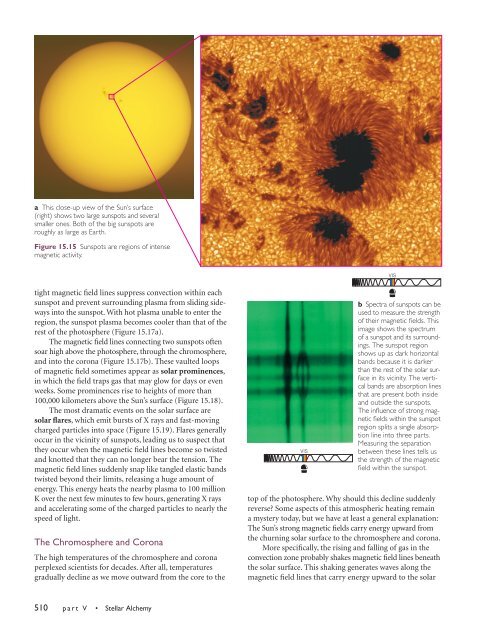Chapter 15--Our Sun - Geological Sciences
Chapter 15--Our Sun - Geological Sciences
Chapter 15--Our Sun - Geological Sciences
You also want an ePaper? Increase the reach of your titles
YUMPU automatically turns print PDFs into web optimized ePapers that Google loves.
a This close-up view of the <strong>Sun</strong>’s surface<br />
(right) shows two large sunspots and several<br />
smaller ones. Both of the big sunspots are<br />
roughly as large as Earth.<br />
Figure <strong>15</strong>.<strong>15</strong> <strong>Sun</strong>spots are regions of intense<br />
magnetic activity.<br />
VIS<br />
tight magnetic field lines suppress convection within each<br />
sunspot and prevent surrounding plasma from sliding sideways<br />
into the sunspot. With hot plasma unable to enter the<br />
region, the sunspot plasma becomes cooler than that of the<br />
rest of the photosphere (Figure <strong>15</strong>.17a).<br />
The magnetic field lines connecting two sunspots often<br />
soar high above the photosphere, through the chromosphere,<br />
and into the corona (Figure <strong>15</strong>.17b). These vaulted loops<br />
of magnetic field sometimes appear as solar prominences,<br />
in which the field traps gas that may glow for days or even<br />
weeks. Some prominences rise to heights of more than<br />
100,000 kilometers above the <strong>Sun</strong>’s surface (Figure <strong>15</strong>.18).<br />
The most dramatic events on the solar surface are<br />
solar flares,which emit bursts of X rays and fast-moving<br />
charged particles into space (Figure <strong>15</strong>.19). Flares generally<br />
occur in the vicinity of sunspots, leading us to suspect that<br />
they occur when the magnetic field lines become so twisted<br />
and knotted that they can no longer bear the tension. The<br />
magnetic field lines suddenly snap like tangled elastic bands<br />
twisted beyond their limits, releasing a huge amount of<br />
energy. This energy heats the nearby plasma to 100 million<br />
K over the next few minutes to few hours, generating X rays<br />
and accelerating some of the charged particles to nearly the<br />
speed of light.<br />
The Chromosphere and Corona<br />
The high temperatures of the chromosphere and corona<br />
perplexed scientists for decades. After all, temperatures<br />
gradually decline as we move outward from the core to the<br />
VIS<br />
b Spectra of sunspots can be<br />
used to measure the strength<br />
of their magnetic fields. This<br />
image shows the spectrum<br />
of a sunspot and its surroundings.<br />
The sunspot region<br />
shows up as dark horizontal<br />
bands because it is darker<br />
than the rest of the solar surface<br />
in its vicinity. The vertical<br />
bands are absorption lines<br />
that are present both inside<br />
and outside the sunspots.<br />
The influence of strong magnetic<br />
fields within the sunspot<br />
region splits a single absorption<br />
line into three parts.<br />
Measuring the separation<br />
between these lines tells us<br />
the strength of the magnetic<br />
field within the sunspot.<br />
top of the photosphere. Why should this decline suddenly<br />
reverse? Some aspects of this atmospheric heating remain<br />
a mystery today, but we have at least a general explanation:<br />
The <strong>Sun</strong>’s strong magnetic fields carry energy upward from<br />
the churning solar surface to the chromosphere and corona.<br />
More specifically, the rising and falling of gas in the<br />
convection zone probably shakes magnetic field lines beneath<br />
the solar surface. This shaking generates waves along the<br />
magnetic field lines that carry energy upward to the solar<br />
510 part V • Stellar Alchemy
















